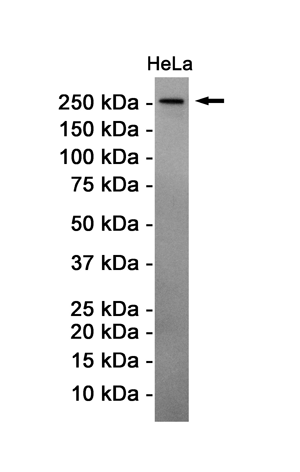
| WB | 咨询技术 | Human,Mouse,Rat |
| IF | 1/20 | Human,Mouse,Rat |
| IHC | 咨询技术 | Human,Mouse,Rat |
| ICC | 技术咨询 | Human,Mouse,Rat |
| FCM | 咨询技术 | Human,Mouse,Rat |
| Elisa | 咨询技术 | Human,Mouse,Rat |
| Aliases | ATM; Serine-protein kinase ATM; Ataxia telangiectasia mutated; A-T mutated |
| Entrez GeneID | 472 |
| WB Predicted band size | Calculated MW: 351 kDa; Observed MW: 351 kDa |
| Host/Isotype | Rabbit IgG |
| Antibody Type | Primary antibody |
| Storage | Store at 4°C short term. Aliquot and store at -20°C long term. Avoid freeze/thaw cycles. |
| Species Reactivity | Human |
| Immunogen | Recombinant protein of human ATM |
| Formulation | Purified antibody in TBS with 0.05% sodium azide,0.05%BSA and 50% glycerol. |
+ +
以下是3-4篇关于ATM抗体的代表性文献,按研究领域和内容分类整理:
---
### 1. **文献名称**: *The complete sequence of the coding region of the ATM gene reveals similarity to cell cycle regulators in yeast and Drosophila*
**作者**: Savitsky, K. et al.
**摘要**:
该研究首次完整测序了ATM基因的编码区,发现其编码的蛋白与酵母和果蝇中调控细胞周期的蛋白存在结构相似性,提示ATM可能通过磷酸化作用参与DNA损伤修复和细胞周期调控。此研究为后续ATM抗体在功能研究中的应用奠定了基础。
---
### 2. **文献名称**: *Ataxia-telangiectasia: diagnosis and treatment*
**作者**: Chun, H.H., Gatti, R.A.
**摘要**:
文章系统总结了共济失调毛细血管扩张症(A-T)的临床诊断方法,提出通过检测ATM蛋白表达水平(使用特异性ATM抗体)和基因突变分析作为诊断标准,并探讨了ATM功能缺失与癌症易感性的关联。
---
### 3. **文献名称**: *ATM and the molecular pathogenesis of ataxia telangiectasia*
**作者**: Shiloh, Y., Ziv, Y.
**摘要**:
综述了ATM蛋白在DNA双链断裂(DSB)响应中的核心作用,包括其通过磷酸化靶蛋白(如p53、CHK2)调控细胞周期检查点和凋亡。研究强调了ATM抗体在检测蛋白表达及功能研究中的关键作用。
---
### 4. **文献名称**: *ATM mutations in cancer: therapeutic implications*
**作者**: Weber, A.M., Ryan, A.J.
**摘要**:
分析了ATM基因突变在多种癌症(如乳腺癌、胰腺癌)中的发生频率,并探讨了ATM缺陷肿瘤对PARP抑制剂的敏感性。研究通过ATM抗体检测肿瘤样本中ATM蛋白表达缺失,为靶向治疗提供依据。
---
**备注**:以上文献为代表性研究,如需具体实验细节或最新进展,建议通过PubMed或Web of Science以“ATM antibody”或“ATM protein function”为关键词检索近五年文献。
ATM (ataxia-telangiectasia mutated) antibodies are autoantibodies targeting the ATM protein, a critical kinase involved in DNA damage response and genomic stability. The ATM gene, mutated in the rare autosomal recessive disorder ataxia-telangiectasia (A-T), encodes a protein that coordinates cellular responses to double-strand DNA breaks. ATM activation triggers cell cycle checkpoints, DNA repair, and apoptosis, safeguarding against genomic instability and cancer.
In autoimmune contexts, ATM antibodies are occasionally detected in conditions like systemic lupus erythematosus (SLE) or Sjögren’s syndrome, though their clinical significance remains unclear. Their presence may reflect molecular mimicry or epitope spreading due to chronic inflammation. Studies suggest ATM autoantibodies could interfere with DNA repair mechanisms, potentially exacerbating genomic instability and disease progression. However, their role as biomarkers or pathogenic drivers requires further validation.
Research-grade ATM antibodies are widely used in laboratories to study protein expression, localization, and function in cancer biology and DNA repair pathways. Dysregulated ATM signaling is implicated in tumorigenesis, making it a therapeutic target. Despite progress, understanding the interplay between ATM autoantibodies and disease phenotypes, particularly in autoimmunity, remains an evolving area of study.
×